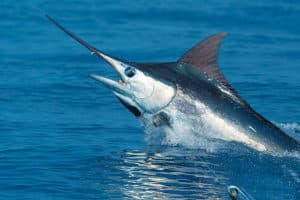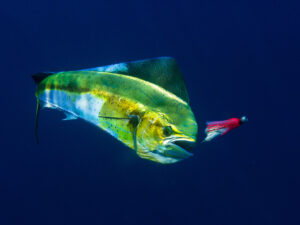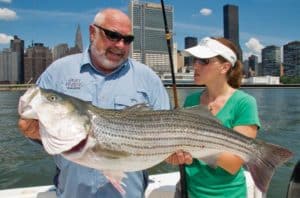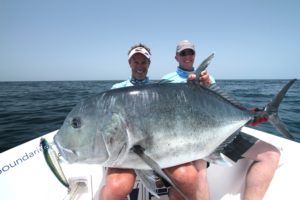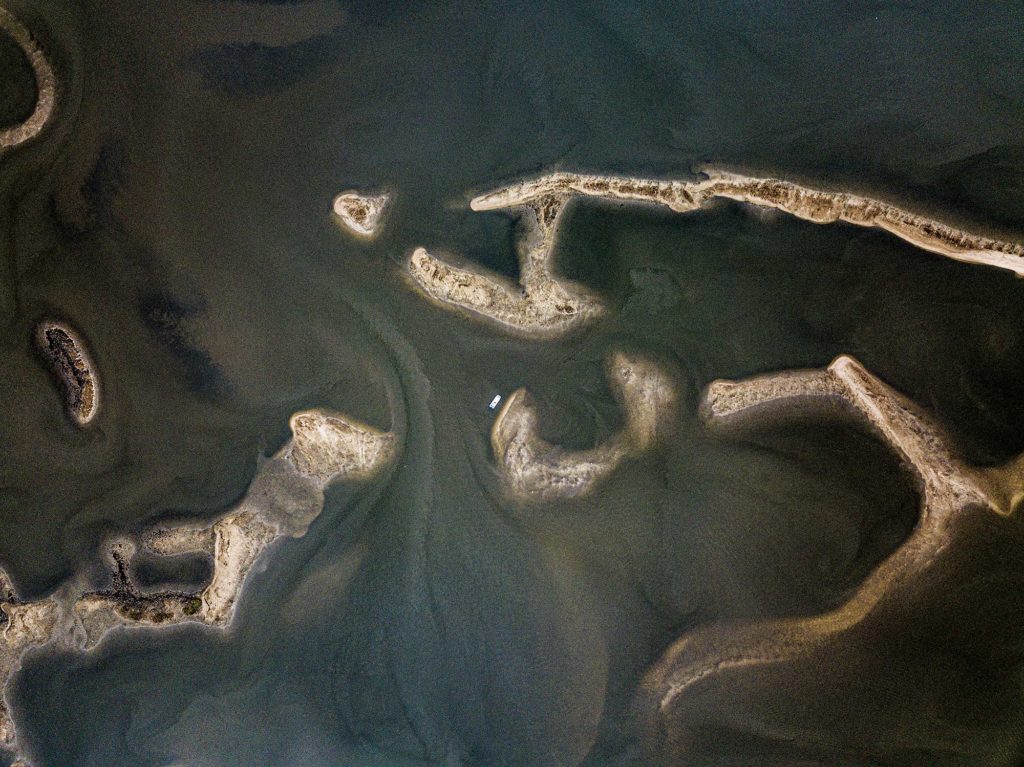
I turned my car onto Cedar Key’s main street, and time stalled. This west coast Florida town, nearly deserted on a mild Monday evening in early November, looked weathered, like a wooden ship. A gaggle of locals gathered at a picnic table outside the quickie mart. The street lay empty.
As someone who grew up in Florida, I remember these quaint coastal towns from my youth. But here was a 21st-century glitch.
My immediate thought: If this location is a legit throwback, what will its inshore fishing be like? I secretly hoped for historical abundance—primeval plenty. Cedar Key delivered.
Close to Everything
Tuesday morning, photographer Adrian Gray, Raymarine/FLIR marketing manager Jim McGowan and I met up with Capt. Jimbo Keith at Cedar Key’s boat ramp and marina. I remember asking Keith the day before by text whether I needed an address to web-map the spot. He simply said, “You can’t miss it.”
In Cedar Key, you’re basically two blocks from everything. Our lodging—the historic Island Hotel—stood within shouting distance of our departure point. After a hot breakfast at the hotel, we piled Gray’s camera gear and drone into my rental car, and parked feet from the dock.
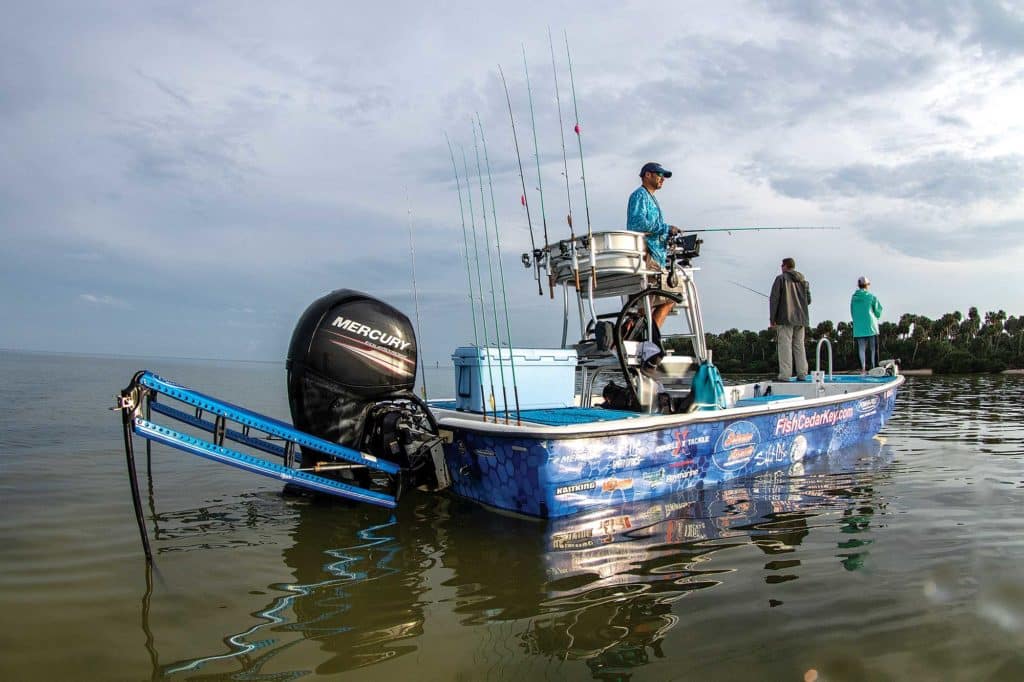
From the elevated helm of his customized, rolled-edge 24-foot Carolina Skiff, Keith idled us toward the expansive local flats. Gray morning clouds hovered over the tiny islets that dot the inshore shallows for miles, stretching west toward the Gulf of Mexico.
The 9-inch Raymarine Axiom display perched atop the console showed a maze of purple tracks, crisscrossing every inch of navigable water, and stopping at Keith’s favorite oyster reefs and honey holes. A satellite-image overlay easily highlighted shallow shoals and humps: All of it created the perfect road map for a productive day.
With his twin Power-Poles, Keith staked us out off Seahorse Key, a 165-acre island that’s part of the Cedar Key National Wildlife Refuge. He handed us spinning rods baited with chunks of cut mullet fished from a typical ⅜-ounce knocker rig, using 15-pound braided main line and 2 feet of 30-pound leader.
“Cast as far as you can that way,” he said, pointing toward a section of shoreline. He explained that we needed to clear an oyster reef positioned between us and the beach.
Pinfish nibbled at our baits as we waited for the telltale slam of a voracious redfish. We didn’t wait long. McGowan’s rod arced; he kept the rod tip high to clear the structure.
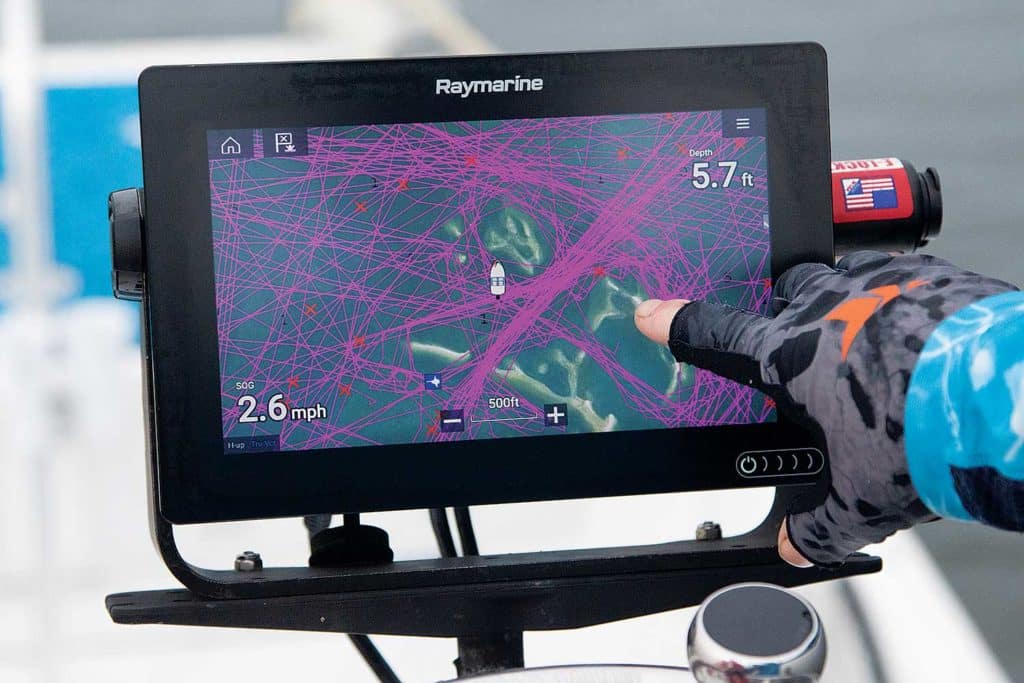
We all hooked up, again and again. As Keith reeled in a puppy drum, I turned on my iPhone camera just in time to capture a shark swirl on the fish nearly boatside, then peel off line before snapping the leader.
Time to move. We had culled a handful of smaller reds, and put four that met the 18-to-27-inch slot into the boat’s cavernous livewell for photography. (Florida regulations allow one red per person per day in the state’s northwest zone.)
On the Menu
Keith motored to another location, where the east-northeast breeze and outgoing tide let us fish a drift with our backs to the wind. Once-daily tides in this region rise and fall about 3 feet a day, and fishable water depths rarely top 10 feet.
These inshore shallows feature sections of oyster bars and sea grasses as well as mangrove-lined shores. Besides redfish, the region produces great numbers of midsize spotted seatrout, as well as seasonal tripletail, cobia and Spanish mackerel, along with occasional tarpon and flounder.

At nearby Snake Key, we found schools of bait moving along the black-mangrove-lined shore. Keith said the opposite side of the key features red mangroves, a better habitat for the few snook that make it this far north. But today’s water temperature hovered at 73.8 degrees, already the low end of optimal for linesiders.
Hoping to catch a few reds on artificial baits, we switched to casting topwater Rapala Skitter Walks. Holding our rod tips close to the water, we worked the lures relatively fast. But the schooling liveys gave us too much competition.
At another shoreline off Seahorse, we walked the lures over lush sea-grass beds punctuated with sand patches. Keith also handed out a few trout rigs: a 4-inch Bass Assassin Sea Shad in glow on a ⅛-ounce jig head tied beneath 3 feet of leader and a B-52 plastic popping cork. Keith said the plastic rattles louder than foam corks.
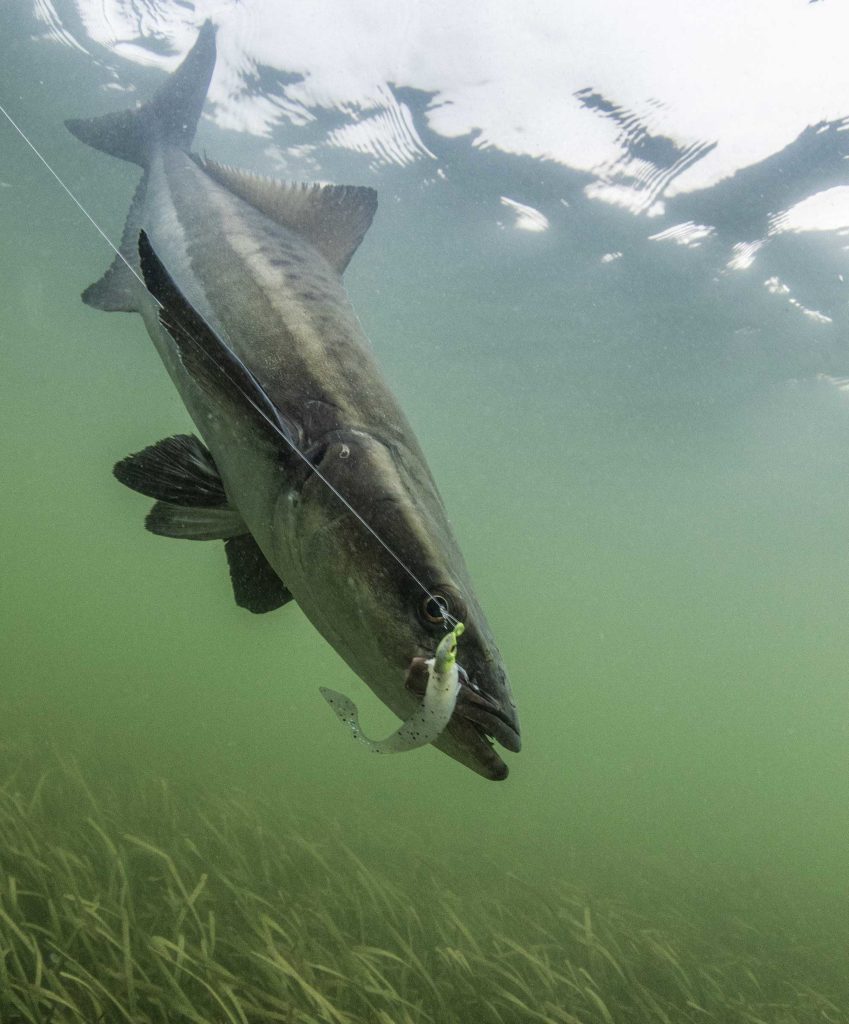
We picked up several school-size trout, and even a legal flounder, casting to holes in the grass. On one drift, my cork dropped so violently, it seemed sucked by a vacuum. At the other end of the line: a surprise cobia.
This summer migrant had obviously stayed past its season. And while the fish wouldn’t meet the legal length of 33 inches, it gave me a quick thrill and another Cedar Key species to notch.
At lunchtime, we made a 10-minute run back to the town’s waterfront, tying up at a transient pier off Dock Street, a promenade lined with shops and restaurants. At Steamers Clam Bar & Grill, we enjoyed a seafood lunch (you have to try the steamed clams), then headed out for the afternoon bite.
Triple Threat
The cool breeze that blew that morning subsided, and the water’s surface slickened. We picked up a few schoolie trout and reds, casting soft-plastic shad baits and topwaters just off Cedar Key, waiting for the tide to flood.
At the change, Keith ran us to an area south of town where clam farmers grow their bivalves and mark the beds with thin stakes every 20 yards or so—perfect conditions for structure-loving tripletail. Late spring through midfall signals the best time to target this species, so we still had a window.
Like a barrel-horse rider, Keith skimmed the outside edge of the stakes in one direction, circled the end marker, then skimmed the inside edge. From the elevated helm, I stared hard into the milky-green water around each stake.
Keith spotted a 20-inch fish a foot or more below the surface. He slowed the boat, and directed Gray to prepare a cork rig and stand on the bow platform. Keith eased the boat back to the stake and idled within casting distance. Gray cast the rig just beyond the marker and slowly reeled it back, giving it a small pop.
Hearts skipped a beat as we watched. The cork vanished.
“He’s on!” I whooped.
The tripletail charged away as Keith used the boat to help Gray pull the fish off the structure. Boatside, its angry-looking black eyes spotted the net, and it ducked below the boat. Moments later, though, Keith expertly scooped up the tripletail and brought it aboard. Dinner in the cooler.
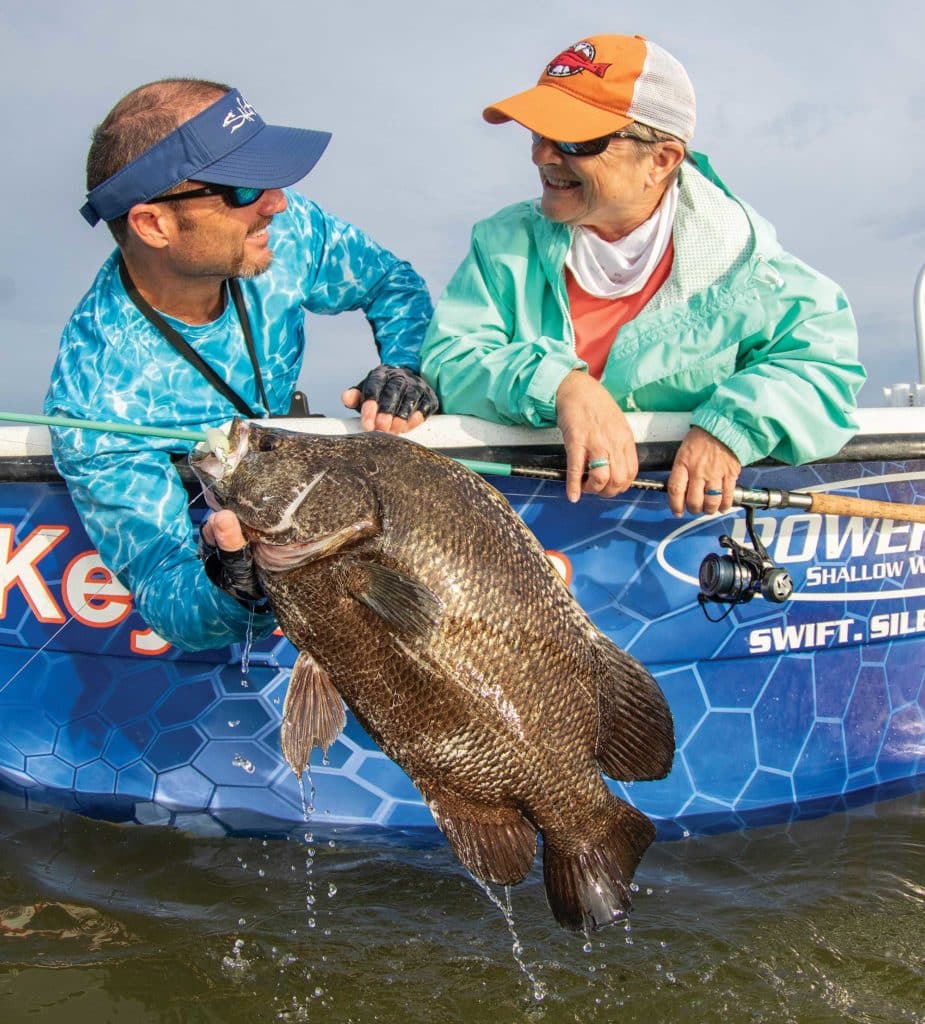
Keith moved us to a surreal-looking flat with a maze of oyster and shell mounds. As I cast off the bow, prospecting for more redfish, Gray and McGowan rigged the drone to fly using the UAV app on the Axiom multifunction display.
Gray shot video and images, and scouted the surrounding structure. He saw some bait but no real feeding activity.
We drifted several more flats during the midafternoon and picked up more redfish, but the overslot bull eluded us. I even hooked a Spanish mackerel on a trout rig, increasing our species count to six for the day.
Capping It Off
The next morning dawned cool and foggy. Keith ran the skiff to the lee side of Deadman’s Key, a small dot of land inshore of Seahorse. As had become the usual pattern, we caught an assortment of small and legal-size redfish but no real money fish—no legit bull red.
Always the optimist, I tossed out another mullet chunk on a knocker rig and waited. Something heavy snatched the bait and began peeling off line before I could even lift the rod. “This one’s bigger, guys,” I said, smiling.
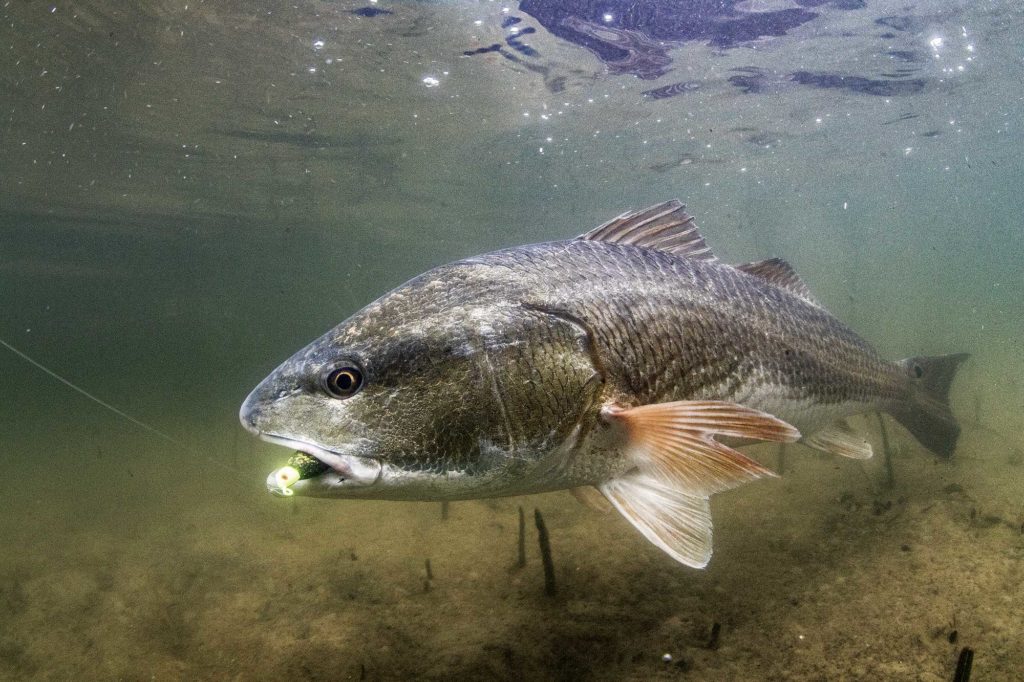
Remembering the previous day’s sharking, I put pressure on the fish. Its quick speed spurts and erratic turns concerned me. But finally, I worked it to the surface and led its head toward the waiting net. Cha-ching: a 30-incher.
While we planned to stay out till the tide slowed, we knew we already had achieved a Cedar Key smorgasbord—in less than 10 hours of fishing. Maybe we really were in a time warp?
Family Tradition
The Keith family—Jimbo and his father, Jim (former tournament pros), plus Jimbo’s uncle and cousin—has grown a charter-fishing empire in Cedar Key since 1985. Their Saltwater Assassin Fishing Charters (fishcedarkey.com) runs four customized Carolina Skiffs. Their tackle arsenal features new and wellmaintained KastKing inshore rods and reels.
Read Next: Fishing Old Florida’s Celebrated Cedar Key
Half-day charters—8 a.m. to noon or noon to 4 p.m.—cost $250 for up to two people ($100 for each additional person). Full-day charters—8 a.m. to 3 p.m.—cost $400 for up to two people ($100 for each additional person, up to four).
About Town
Located along the stretch of Florida’s western seaboard nicknamed the Nature Coast, Cedar Key perches at the end of a state highway about an hour north of Crystal River. Its location reminds me a little of Venice, Louisiana, which some folks jokingly call “the end of the earth.”
Speculators began developing the town of Cedar Key in the late 1850s, anticipating its growth as the western station on the Florida Railroad. The area and nearby islands were named for the eastern red cedar, a once‑abundant native tree.
Merchant John Parsons and his business partner, Francis Hale, built the Island Hotel in 1859 as a general store. The outbreak of the Civil War in 1861 shut down the building boom. Historians speculate that the general store served as a barracks and warehouse for Yankees, who had invaded the town. The store eventually evolved into a boarding house and restaurant in the 1880s.
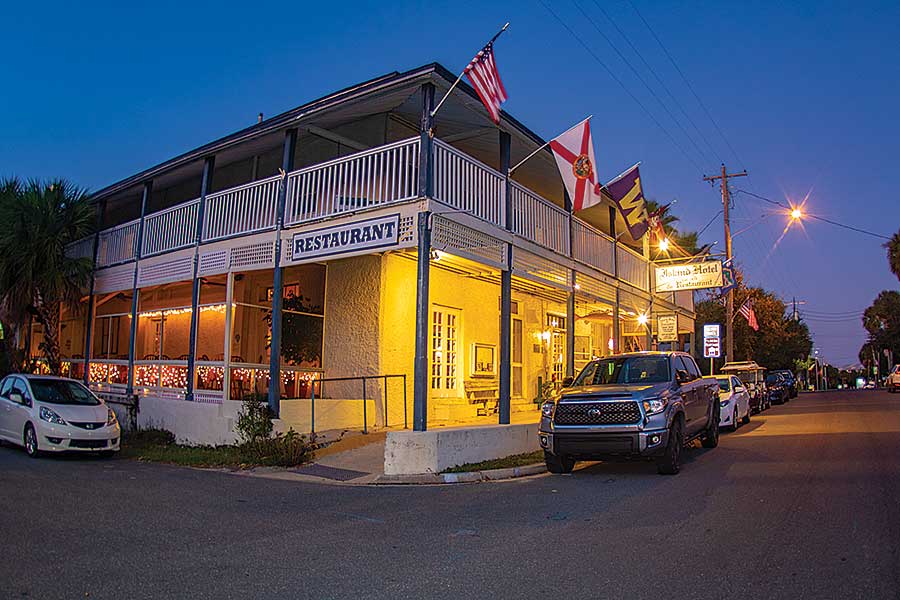
Today’s two-story Island Hotel & Restaurant seems unassuming enough at first glance, but it certainly feels like a step back in time. It’s a repository for fascinating local history (listed on the National Register of Historic Places), and its Neptune Bar serves as a warm, inviting place to meet town residents, many of whom have escaped busier, urban lives.
Proprietors Andy Bair and his wife, Stanley, originally from Atlanta, ran the popular Bair Bahamas Guest House on South Andros Island in the Bahamas before coming back to the States in 2003—in search of “that one last, quiet undeveloped spot” that might still be found in Florida.
Their hotel’s 10 rooms feature hand-cut wooden walls and floors; all have private bathrooms. While the structure and all sleeping quarters offer air conditioning, the Bairs have kept out the televisions and phones. Room rates—which range from $90 to $155 a night—include a full breakfast each morning.
The kitchen staff also will prepare your catch and serve it to you in the downstairs restaurant. (During our last night, we enjoyed redfish and flounder three ways as we sat in the cedar-lined bar listening to local musicians the Taylor-James Gang.)
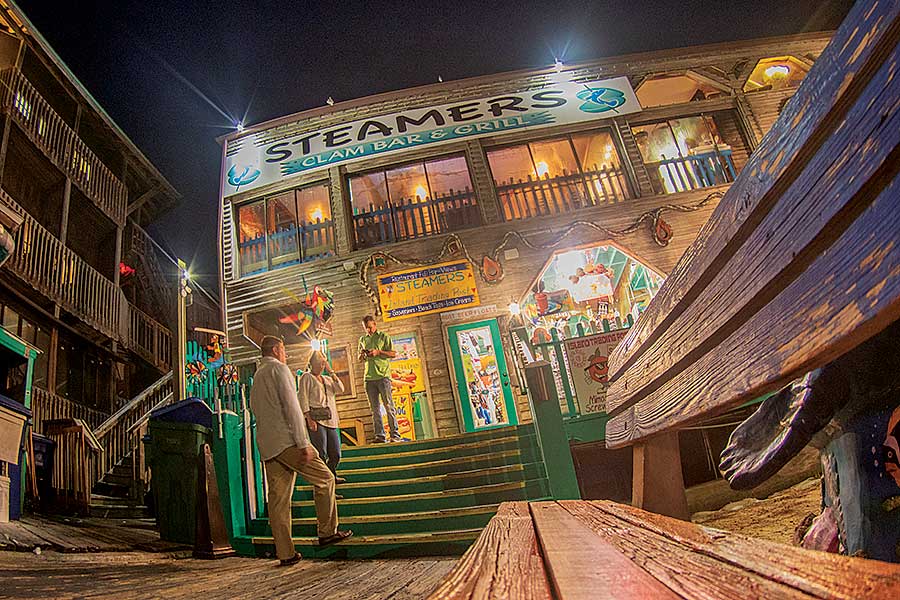
We ate most of our meals on the water at Steamers Clam Bar & Grill, and its sister “downtown” breakfast-and-lunch spot, 2nd Street Cafe. Steamers serves a variety of seafood and classic favorites with mouthwatering house specialties and abundant helpings; they too will cook your catch.
The cafe prepares a variety of breakfast options as well as sandwiches and salads, including a huge, to-die-for wedge salad.

